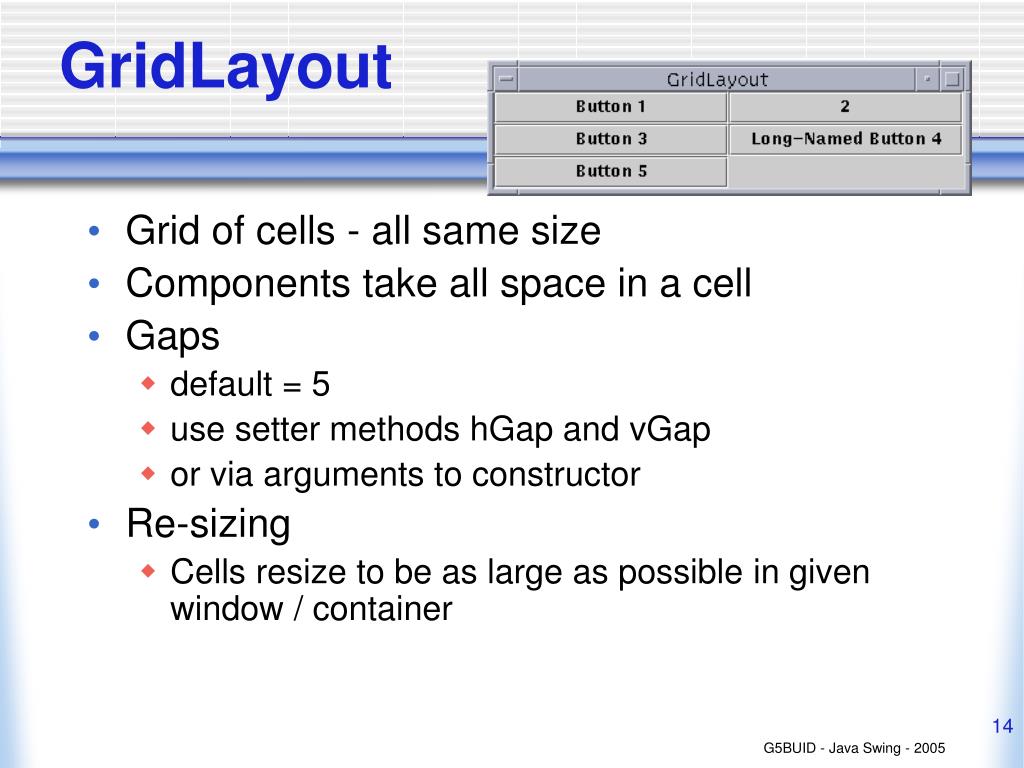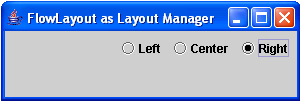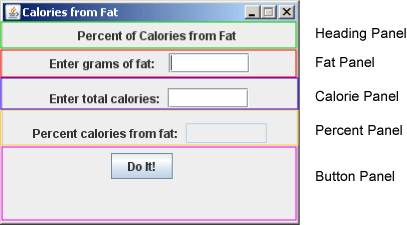

- SET THE LAYOUT MANAGER TO USE THE DEFAULT FLOWLAYOUT HOW TO
- SET THE LAYOUT MANAGER TO USE THE DEFAULT FLOWLAYOUT CODE
- SET THE LAYOUT MANAGER TO USE THE DEFAULT FLOWLAYOUT SERIES
Figure 1 illustrates some of these combinations. Given that you must specify both horizontal and vertical alignments for each cell, row, column, or layout, you can choose from 16 possible alignment combinations (not all of them particularly useful).

SRLayout (short for ScaledRowLayout): Manages a 1 x n grid (1 row, n columns).SGLayout serves as the base class for a family of layout managers. The example does, however, demonstrate how SGLayout makes implementing complex layouts possible. This example seems silly, considering that no sensible GUI would have such a mixture of alignments.

Note that the layout manager for each of these panels is a PointLayout instance (see below). The button in cell 1, 1 and the label in cell 2, 1 are added to panels that are in turn added to contentPanel. The texts in Figure 1 describe the alignments for most of the grid cells. Make sure that none of the statements cancel an earlier statement (you should work on a row or column basis first, then finish on the individual cells).įinally, several labels, panels, and a text field are added to the contentPanel. tAlignment(2, 1, SGLayout.FILL, SGLayout.FILL) tAlignment(2, 0, SGLayout.FILL, SGLayout.BOTTOM) tAlignment(1, 0, SGLayout.RIGHT, SGLayout.FILL) Next, you change the individual cells' alignment (on a row, column basis): tAlignment(0, 1, SGLayout.LEFT, SGLayout.CENTER) This statement changes the alignment of all grid cells in the 0th column. The scale values are all relative and are maintained on resizing of the container: tColumnAlignment(0, SGLayout.RIGHT, SGLayout.TOP) These statements make row 1 wider (by a factor of 2.0 relative to rows 0 and 2, which have a 1.0 default scale-value) and column 0 narrower than column 1 (by a factor of 0.65).
SET THE LAYOUT MANAGER TO USE THE DEFAULT FLOWLAYOUT SERIES
(Note that the conventional schizophrenia applies: rows before columns, but X-axis before Y-axis.)Ī series of statements then destroys that arrangement's simple order: tRowScale(1, 2.0) The component added to each grid position will fill the position in both the X- and Y-directions, and there will be a 15-pixel gap between the columns and 5-pixel gaps between the rows. The layout manager in this case defines management of three rows and two columns. SGLayout contentLayout = new SGLayout(3, 2,, SGLayout.FILL,įigure 1. (I implemented this demo as SGDemo.java.) A JPanel instance, to which an SGLayout manager has been set, replaces the JFrame's contentPane: JPanel contentPanel = new JPanel() I commence discussion with a rather silly GUI frame, seen in Figure 1, that illustrates SGLayout's possibilities.
SET THE LAYOUT MANAGER TO USE THE DEFAULT FLOWLAYOUT CODE
Note: You can download this article's complete source code from Resources. In so doing, I incorporated much of GridBagLayout's alignment power. Thinking I could improve upon GridLayout, I wrote SGLayout as a complete replacement.
SET THE LAYOUT MANAGER TO USE THE DEFAULT FLOWLAYOUT HOW TO
In one example, a simple password panel, Dorohonceanu incorporates a series of labeled text fields into a grid and shows how to improve the panel's appearance by decreasing the label column's width relative to that of the text field column. In this Java Tip, I describe a layout manager, SGLayout, with similar flexibility and direct control over margins, gaps between rows and columns, and fine control over how to locate a component within the grids.

In " Java Tip 121: Flex Your Grid Layout" ( JavaWorld, December 2001), Bogdan Dorohonceanu describes a GridLayout subclass that avoids the requirement that a grid's elements possess the same dimensions. With that in mind, a better way to get similar results must exist. On this basis, GridBagLayout gets particularly poor marks. Personally, I follow the "least surprise" principle when I look at layout managers: If you are surprised at a layout manager's behavior, it probably was designed poorly. GridBagLayout, in particular, is very powerful, but many developers find it difficult and nonintuitive. Of these, BorderLayout and FlowLayout generally prove useful, but developers often start running into difficulties when coding more complex layouts. A good layout manager proves essential for creating a good graphical user interface (GUI), but many beginner developers find the standard Java layout managers difficult to master.


 0 kommentar(er)
0 kommentar(er)
